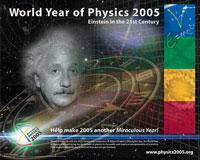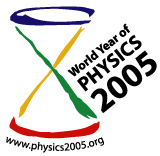2005 Physics Olympics
The World Year Of Physics
Overview
The 2005 Western Kentucky Physics Olympics was held at WKU on Saturday morning, April 30th, in the Thompson Center, Central Wing on WKU’s Bowling Green campus. The competition consisted of five events designed to test the physics knowledge, skill with experimental investigations, teamwork, and communication of high school students from around the region. Each team was composed of four students and a coach.
In celebration of the 100th anniversary of Albert Einstein's 'miraculous year' of 1905, The Einstein Centenary was the theme for this year’s Western Kentucky Physics Olympics, a half-day competition consisting of a pentathlon of challenging problem-solving activities that reward teamwork, creativity, and communication.
Each of the five events for 2005 Western Kentucky Physics Olympics was related to the discoveries which Albert Einstein published in 1905:
-
Photoelectric Effect - where teams competed to build "Rube Goldberg" devices that went through multiple steps to burst a balloon;
-
Heavy Water Plunge - where teams designed, constructed and demonstrated a device that would protect a water-filled balloon after repeated drops from a height of 35 feet;
-
Order of Magnitude Quiz;
-
Extremely Non-Relativistic Balloon Race - where teams divided into two groups - one to calculate how much weight a helium-filled balloon could lift and the other to create a load that would slow the balloon's ascent as much as possible; and
-
Brownian Motion- with teams going head to head against each other to shoot rubber bands at a balloon and drive it across the other teams goal line.
Outcome
Overall winners:
The day's competition was very balanced, with each team winning at least one of the
individual competitions. The overall winning team for the competition came from Warren
Central High School and was coached by their teacher, Ken Lee. Each of the four students
from the overall first place team recieved a $500 dollar scholarship to attend WKU:
-
Rachel Kelly (Woodburn),
-
Kevin Marvin (Rockfield),
-
Armin Smailhodzic (Bowling Green), and
-
Dewayne Sowell (Bowling Green).
Event 1: The Photoelectric Effect – the Do-Ahead Project
The photoelectric effect describes a situation where light shines on a metal, releasing electrons. Einstein’s explanation of the photoelectric effect provided strong evidence for the particle nature of light, establishing a phenomenon of light that cannot be explained by light acting as a wave.

The goal of this competition is to design, build and demonstrate a "Rube Goldberg device" that incorporates different energy transfers, including utilizing the photoelectric effect by transferring light energy to electrical energy, to accomplish the task of bursting a balloon.
- Teams will build a device that, in the most indirect and complicated possible manner,
completes the otherwise simple task of popping a balloon within four minutes. The
device’s action will be initiated by an unmodified ping-pong ball being dropped into
the top of the device, triggering a transfer of energy from gravitational potential
energy into some other form of energy, which will trigger another form of energy,
and so on until the final action bursts a helium-filled balloon suspended above the
device.
- The timing will commence when the event supervisor says "go". The clock will not be
stopped if the machine stops, jams, or otherwise fails.
- If an energy transfer should fail to occur -- except the final action responsible
for bursting the balloon -- the team will be allowed to touch or adjust the device
in order to trigger the next action. However, no points will be awarded for a failed
energy transfer.
- The entire device must fit within an imaginary box with dimensions of 0.5 m x 0.5
m x 1.0 m
- Each device must pass a safety inspection before operation. Faulty wiring, hazardous
materials, uncontrolled projectiles, unshielded spills, and commercial batteries will
not be allowed and are grounds for disqualification. Homemade batteries must be demonstrably
safe and environmentally proper disposal must be provided. Matches and candles are
the only flammable substances allowed. Nothing solid or liquid is allowed to leave
the confines of the device, the exception is for light waves, small amounts of smoke,
odors, or gas.
- Six broad classifications of energy forms will be accepted: chemical, electrical, electromagnetic spectrum (light energy, not an electromagnet), mechanical (including pneumatic and hydraulic pressure), and thermal.
- Points will be earned when the team correctly documents the manner in which its device
changes the form of energy being used from one action to the next; although only for
actions which directly contribute toward the final action. Scoring will be based only
on the energy transfers that are listed in the Energy Transfer List submitted to the event supervisors prior to the start of the event.
- The Energy Transfer List provides the sequence of energy transfers to be considered for scoring. This list must be legible and well organized, with one energy transfer per line using the format: initial energy form à action à resulting energy form. An example List follows.
|
step |
initial energy form |
action |
resulting energy form |
transfer |
|
0 |
kinetic |
Falling ping pong ball lands on mouse trap |
mechanical |
0 |
|
1 |
mechanical |
Triggered mouse trap pulls string and releases metal electrode strips into weak acid solution |
chemical |
C1 |
|
2 |
chemical |
battery cell generates current |
electrical |
E1 |
|
3 |
electrical |
current causes light bulb to shine |
E&M spectrum |
S1 |
|
4 |
E&M spectrum |
photons strike photocell, and generate current |
electrical |
E2 |
|
5 |
electrical |
current flowing through thin wire generates heat |
thermal |
T1 |
|
6 |
thermal |
heated wire melts skin of the balloon, bursting it |
chemical |
C2 |
- Points will be awarded as follows:
- 10 points will be awarded for the first six times any form of energy is converted to each of the accepted energy forms (300 points max). For instance, 60 points will be awarded for the first six successful instances of some energy form being converted to chemical energy. Transfers to that energy form after the 6th successful instance will earn no points.
- Photoelectric Effect Bonus: 15 points for each time electromagnetic spectrum energy is transferred to electrical energy.
- 300 points will be awarded for successfully bursting the balloon via an acceptable energy transfer within the four-minute time limit.
- Penalty points will be deducted as follows:
- 10 points off for each inaccurate line in the Energy Transfer List,
- 75 points off for incorrectly formatted, incoherent, or illegible Energy Transfer List,
- 110 points off for parallel or dead-end paths,
- 200 points off for size violation,
- 50 points off for the first time any solid, liquid, or large amount of smoke, odor, or gas leaves the boundary of the device prior to the final action; the second instance disqualifies the device.
- Ties will be broken according to (1) least number of penalty points, (2) completion
time closest to 90.0 seconds, (3) the judges’ subjective assessment of the tower’s
aesthetics (construction quality, decoration, etc.).
- All contestants will ensure that their entry works through the application of physics principles and generally follows the spirit of the competition.
Event 2: Protected Heavy Water Plunge – the Plan-Ahead Project
 Nuclear fission, whether controlled in a nuclear power reactor or uncontrolled in
an atom bomb, is a by-product of Einstein’s Special Theory of Relativity and the principles
summarized in the equation, E = mc2. For various reasons, heavy water is essential to the operation of many nuclear power
reactors. Heavy water is chemically the same as regular water, but with the two hydrogen
atoms replaced with deuterium (an isotope of hydrogen with one extra neutron) atoms.
It is the extra neutrons that make heavy water "heavy", about 10% heavier in fact.
Most nuclear power reactors in the USA use ordinary water to transfer heat and moderate
the speed of the emitted neutrons. However, ordinary water absorbs neutrons, so these
light water reactors must use enriched fuel.
Nuclear fission, whether controlled in a nuclear power reactor or uncontrolled in
an atom bomb, is a by-product of Einstein’s Special Theory of Relativity and the principles
summarized in the equation, E = mc2. For various reasons, heavy water is essential to the operation of many nuclear power
reactors. Heavy water is chemically the same as regular water, but with the two hydrogen
atoms replaced with deuterium (an isotope of hydrogen with one extra neutron) atoms.
It is the extra neutrons that make heavy water "heavy", about 10% heavier in fact.
Most nuclear power reactors in the USA use ordinary water to transfer heat and moderate
the speed of the emitted neutrons. However, ordinary water absorbs neutrons, so these
light water reactors must use enriched fuel.
The goal of this competition is to construct a device that will ensure the survival of a water-filled balloon after repeated drops from a height greater than 30 feet. The balloons will not be filled with heavy water. The speed of the falling balloons will not involve the special theory of relativity. In fact, other than the overreaching name for this competition, there is actually no connection between this event and the 100th anniversary of Einstein’s miraculous year. Oh well.
- The object of the contest is to design and construct a device that will protect a
water-filled balloon when dropped repeatedly onto a hard surface from a height greater
than 30 feet. One point will be awarded each time an entry achieves an acceptable
drop. The final score will be determined by the sum of the points scored, with ranking
order by high score.
- Each team may enter one device; designed, constructed, and operated by the team members.
There is no restriction on building materials. The only design limitation is that
the apparatus in its entirety must be able to fit inside an imaginary cube with 40-cm
sides. The device must be designed and built with no question as to the safety and
quality. At any point before or during the competition, entries which are deemed by
the judges to be unsafe will not be allowed to be dropped and will receive no further
points.
- Judges will supply the filled water balloons for the payload. A standard latex balloon,
listed on the package as “7-inch Round”, will be filled with 400 milliliters of water,
resulting in an approximate diameter of 9-centimeters.
- Team members will be responsible for inserting the balloon into the protective device.
At any time after insertion, the status of the balloon must be able to be demonstrated
by either a visual or physical inspection by the judges. Once the team members have
inserted the water balloon into the protective device (and if applicable, the protective
device attached to an external frame), no further adjustments or alterations are allowed.
- For each scoring drop, the entire apparatus must land in the designated 1.2-meter
diameter circular target area. All parts of the apparatus must remain within a 4-meter
diameter circle centered on the target area.
- A previously identified team member will be responsible for clearly announcing each
drop just before it is made. No score will be recorded for any device that is dropped
prior to an announcement of an impending launch.
- Competitors and guests will not be allowed within a 5-meter radius circle surrounding
the target area. The penalty for violation is immediate forfeiture of the event.
- The apparatus will be released each time by one member of the team; who will be responsible
for successfully hitting the target. For scoring purposes, the point of initial contact
will be determined by the judges. Any part of the device touching the outer boundary
will be deemed as out of bounds and unacceptable. Once any part of the device is deemed
out of bounds, that drop will not count toward the final score.
- One point will be awarded each time a team lands the device within the boundary without
bursting the payload. Once the water balloon bursts, the team will not be allowed
further attempts. One of three “byes” will be awarded each time an entry achieves
an unacceptable, yet intact, drop. Once all three “byes” have been used, a fourth
unacceptable drop will result in the team receiving no further points. The final score
will be determined by the sum of the points scored for each acceptable drop, with
ranking order by high score.
- In the event of a tie, the first tiebreaker will be determined by the least use of
safeties by the competitors. For the second tiebreaker, each team is required to submit
a prediction of the size of the device’s spread after the first landing. For each
drop, judges will measure distance from the target center to the farthest portion
of the balloon protection device as it spreads out after impact. Secondary ties will
be broken by the accuracy of the team’s prediction.
- All contestants will ensure that their entry works through the application of physics principles and generally follows the spirit of competition.
Event 3: Extremely Non-Relativistic Balloon Race -Communication / Calculation Challenge
Students will use teamwork, communication and calculation skills to achieve the specified goal. Two members of the team will be presented a set of measurements to make. The remaining two team members will be presented with this set of measurements and be required to compute the desired properties from the data with no additional communication. Finally, the judges perform the test and score the team's effort according to the announced guidelines.
Event 4: Impromptu Team Physics Activity – Brownian Motion
Activity is the key word for this competition, with the goal being for each team to achieve the desired result as quickly as possible. The situation is designed to reward teamwork and common sense thinking as well as knowledge of physics and the ability to work with formulae. Every team will come away with smiles and good memories regardless of how well they master the particular challenge.
 Event 5: Order-of-Magnitude Quiz (also known as Fermi Questions)
Event 5: Order-of-Magnitude Quiz (also known as Fermi Questions)
Arrive at a reasonable approximation for the value of a complex situation with very little to no information available to directly compute the answer. In this quiz, the contestants will need to quickly make assumptions for values to use in simple calculations in order to arrive at the "correct" answer, stated as the power of ten of the number that fits the accepted value.
Teams will receive 7 questions to complete within 15 minutes. The teams can divide the work in any way they see fit, but only one answer per question per team will be accepted.
Answers will be judged according to how many orders of magnitude the team's answer is from the judge's solution. The lowest score wins -- 0 points awarded for the answer accepted by the panel of judges, with 1 point scored per order of magnitude from the accepted value.
Examples of Order-of-Magnitude Quiz questions include:
- How many electrons enter the starter motor when a new, full-sized pickup starts?
- How many times would a tire of a Ford Taurus rotate when driven from NYC to LA?
- Estimate the number of gallons of gasoline used annually by all the cars in the USA.
A community of faculty, staff, and students engaged in better understanding the physical world.
Some of the links on this page may require additional software to view.


